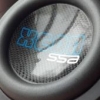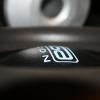Leaderboard
Popular Content
Showing content with the highest reputation on 08/05/2010 in Posts
-
1 pointIf you tune to 35 hz, you'll get a taller hump in frequency response above tuning and faster rolloff below tuning. If you tune to 27 hz the frequency response will be more flat. Basically, 35 hz will be louder, 27 hz will be more even.
-
1 point
-
1 pointSingle Icon 12 It will be getting maroon carpet as well. It seems to be a new trend now lol.
-
1 pointWith a ported enclosure you have well... a port. That is basically an open hole of known surface area and length which tunes a box of known volume to a specific frequency. The resistance of the tuned port is very high above tuning and near/at tuning it resonates increases the amplitude at those frequencies. Below the tuning it unloads and simply becomes a "hole" in the box. This is a problem as the speaker is now essentially functioning in free air. Not a problem when its below its max limits, but still not yielding appreciable output vs its excursion levels... so why run things so hard for so little output. At the same time, people are often beating on their system HARD when this occurs and when they end up playing a track below tuning things REALLY go wild and unload. This will mechanically damage the speaker due to over excursion. Ripped/torn parts, fatiguing the lead wire... all sorts of bad. So, we place a sticker on the front of the box telling useful tips on setting up your system... and to me one of the biggest ones (if not the biggest) is to set the subsonic filter properly for ported systems. This is true of all subs. Not just ours. Now if you have a decent mechanical excursion sub with relatively no Xmax, it isnt as much of a problem simply due to the fact it has little linearity vs the high mechanical excursion. But on most modern subs where Xmax is closer to 75% of mechanical limits... you can power it linear right up to the point where it wants to break itself. Do yourself and the sub a big favor and set the filter a couple of Hz below tuning. If you are unsure of where that is, err on the side of caution and set it higher than needed. You can eventually back down when things break in and you "know" the system a little better. Learning curves are our friends. Thanks, Scott
-
1 pointBecause of varying distances between the listener and the drivers, vehicle nodes and acoustics, etc, and how they relate to a frequency's wavelength and phase when the sound reached your ears. Wiring interior speakers out of phase is not at all like wiring subs in the same box out of phase in terms of performance consequences. For example, say you're 1 foot from speaker A and 3 feet from speaker B, and you play a frequency has a wavelength of 4 feet. When the sound from speaker A reaches you, the wavelength will be at its peak position (we'll say the +1 position, relative to a 0 line). But when the wave from speaker B hits you, due to the increased distance from the speaker, the wavelength is at its trough, or -1 position. That means the sound waves are 180 degrees out of phase with each other and will cancel out. If you reverse polarity of one of the speakers, say speaker B, the sound wave will reach your ears with the wavelength at the peak/+1 position, just like speaker A, thus reinforcing the sound and not cancelling it out. The time alignment feature on many head units today are there due to the distance discrepencies between the listener and each speaker in a car audio environment. You don't sit in the middle of your car (unless you drive a McLaren F1), so each speaker is offset from your ears a different distance. Time alignment retards the signal to certain speakers so that the sound waves reach your ears at the same time from each speaker. It's a different concept than reversing polarity like I mentioned above, but same end goal in mind of aligning wavelengths.
-
1 point
-
1 point90% of the time that is not the case. Normally the one and only thing that changes is cone area, motor, coil, softparts, they are all the same so power handling is not effected. Right. Most models of subs use everything the same for each size of sub except for basket size and cone size. In this case the power handling among different sizes would be exactly the same. However, the slightly larger moving mass from the increased cone size can slightly shift several parameters. Is it enough to be heard, maybe. Sometimes a 15" in this scenario has an fs 3-5 hz below the 12", which may be discernible. Having boxes at the same tuning might actually make the difference more audible due to the difference in frequency response. If you want to compare the different sized subs in similar boxes, you actually need to equalize the Qtc and the f3 point of the boxes. That may mean you have to tune the 12" to 29 or 32 hz, or whatever. Some models of subs actually use different motors, or at least coils, in their different subs. I know I've seen lines where the 10" and 12" use a 2" coil, whereas the 15" uses a 2.5" coil. I think MTX used to do that. Alpine might also have. In that case, nearly all bets are off depending on how closely the manufacturer wanted to make the specs. The 15" could be such a different animal that it could actually belong in its own model line and not grouped with the 10 and 12 inch versions. Or they could make it so that the 15" has very close specs to the other sizes by machining the motor a little differently.
-
1 pointNow that the rear of the car is done on the outside we think it is about time to start putting together the hatch area. Some pics of the components going in the back. We got the hatch panels installed. If the rca connections look a little weird they will make some sence once we start getting the sub enclosures installed. By sefugi at 2010-07-31 By sefugi at 2010-07-31 By sefugi at 2010-07-31 Here are the subs. 2-10's and 1-15. By sefugi at 2010-07-31 By sefugi at 2010-07-31 Amps will be as follows-2 4channels and 2 monoblocks. By sefugi at 2010-07-31 By sefugi at 2010-07-31 By sefugi at 2010-07-31 By sefugi at 2010-07-31
-
1 pointNow time to move to the rear bumper.... This is the blank slate of the rear of the car. By sefugi at 2010-07-31 My son trimming the mesh screen in the bumper around the muffler as we are fitting bumper to the car. By sefugi at 2010-07-31 By sefugi at 2010-07-31 Splash guards for rear bumper. We fitted them as best as possible due to the difference in the aftermarket bumper and the oem. Turned out good and gave the rear bumper a little support on the sides. By sefugi at 2010-07-31 By sefugi at 2010-07-31 Mesh screen on passenger side of rear bumper and the screen my son trimmed to fit the muffler. Wasn't going to install screen on muffler side but my thought it would be much better and I think he was right. By sefugi at 2010-07-31 By sefugi at 2010-07-31 Sound deadener on license plate and plate trim. By sefugi at 2010-07-31 Backup camera and LED replacements for the tag light. By sefugi at 2010-07-31 Couple of shots of rear bumper installed and rear tail lights. By sefugi at 2010-07-31 By sefugi at 2010-07-31 By sefugi at 2010-07-31
-
1 pointI'm down to what I hope is my last major mods, bolting down the center brace. This is usually a simple nut and bolt affair, but in my situation it's never that simple. I'll be bolting the center brace to the section of the rear floor pan that rolls up supporting the lower seat back. Complicating things is the gas tank blocks the holes from the underside of the car. Luckily there is a solution to simplify the ordeal. I'll be using some rivet nuts and a special hand riveter like tool to install them. Rivet nuts are like rivets in that they compress onto the sheet metal, but they have threads on the inside to provide mounting location for bolts. Snazzy, huh? Here is the installation tool. I picked this up at Harbor Freight. Came with different size mandrels for popular machine screw sizes. The rivet nuts that came with it are made of aluminum and they suck. I picked up these zinc plated steel ones from Mc Master Carr. It's pretty straight forward. Here is the insert next to the mandrel Thread the insert onto the mandrel. Insert the rivet nut into the hole and squeeze the handle to compress the rivet nut onto the sheet metal. Here are the holes I drilled to mount the center brace. It's important to get the hole size right. Here is the rivet nuts installed. A threaded mounting provision in sheet metal, or what I'd like to call heaven on earth. The center brace is finally in place.
-
1 pointI transferred the cardboard template to the MDF cover. Here is the MDF cut. I looks a little funny. I couldn't resist. I put the factory insulation back in place. Finally the rear cover is back in place. I put some threaded inserts in the MDF and bolted it in place from the underside of the rear deck.
-
1 pointI made some paper templates using a fancy 3-D modeling software. I printed them to scale and cut them out. I put them in place and drew some reference marks. You can see my reference marks at the bottom of the paper template. I used the factory insulation as a template, and transferred it's shape on to some cardboard. Here is the card board in place. I transferred my reference marks on to the cardboard. These will help me get the paper templates in the right location on the cardboard template. Here are the paper templates in place lined up with my reference marks. Here is the cardboard template back in the car for a test fit. The speaker cutouts lined up nicely.
-
1 pointHey everybody, I'm back. After so many days in a row on this project I had to get back and tend to my fatherly duties. No I'm not a priest, just a family man. I left this project with the rear deck in question. This is where I'll pick up. I started off by tracing the original rear deck cover on to a piece of 1/2" thick piece of MDF. Here is my outline I use a square to complete incomplete lines. These always come in handy and can be found on the cheap at Walmart. Just square up to the two lines Viola. Lines completed. Here is the new cover ready to cut The finished product. Well, not yet. I still need the speaker cut outs.
-
-1 points





